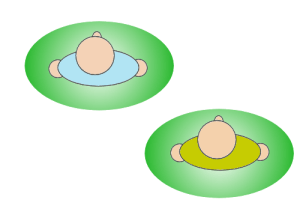Personal space facts for kids
Personal space is a concept from sociology, which is the study of how people live and interact in groups. It's about the invisible "bubble" of space that each person has around them. This idea suggests that the closer you feel to someone emotionally, the closer you usually let them stand to you without feeling uncomfortable.
The idea of personal space was first introduced by Edward T. Hall in 1966. If someone steps into your personal space without you wanting them to, it can make you feel awkward or uncomfortable.
The amount of space a person needs can be thought of in two main ways:
- Your immediate personal bubble: This is the small, invisible area right around your body that you feel is yours.
- Your territory: This is a larger space, like your room or a favorite spot, that you consider your own. The size of this "territory" depends on many things, such as how much room you need, your daily habits, or even how animals behave in their own areas.
Hall's ideas about personal space were based on studies of zoo animals by Heini Hediger in 1955.
Contents
Understanding Your Space Bubble
Everyone has a personal space bubble, but its size can change. It's like an invisible shield that protects you. When people respect this space, you feel safe and comfortable. If someone gets too close without an invitation, it can feel like they are invading your privacy.
Why Personal Space Matters
Personal space is important for many reasons. It helps us feel secure and in control of our interactions. It also shows respect for others. When you understand personal space, you can better understand how people communicate without words. This is a big part of nonverbal communication.
Different Zones of Space
Edward T. Hall described different zones of personal space. These zones help explain how close we allow others to get to us, depending on our relationship with them:
- Intimate distance: This is for very close friends, family, or partners. It's usually from touching to about 18 inches away.
- Personal distance: This is for friends and close acquaintances. It's typically from 1.5 feet to 4 feet away. You might stand this close to a friend when chatting.
- Social distance: This is for people you don't know well, like classmates or colleagues. It's usually from 4 feet to 12 feet away. This is common for group discussions or formal meetings.
- Public distance: This is for public speaking or large groups. It's usually 12 feet or more away. Think of a teacher speaking to a classroom.
These distances can change based on culture, situation, and personal preference.
How Culture Affects Space
The amount of personal space people need can be very different depending on their culture. In some cultures, people stand very close when talking, and it's considered normal. In other cultures, people prefer more distance. For example, people from some parts of Latin America or the Middle East might stand closer than people from North America or Northern Europe. Understanding these differences helps us avoid misunderstandings when interacting with people from different backgrounds.
Personal Space in Daily Life
You use personal space every day without even thinking about it.
- When you are on a crowded bus, you might try to make yourself smaller to respect others' space.
- When you are talking to a friend, you naturally find a comfortable distance to stand.
- When you are in a library, you might keep your voice down and not spread your belongings too widely to respect the shared space.
Understanding personal space helps you navigate social situations more easily and respectfully. It's a key part of how we interact with the world around us.
Images for kids
See also
 In Spanish: Proxemia para niños
In Spanish: Proxemia para niños



